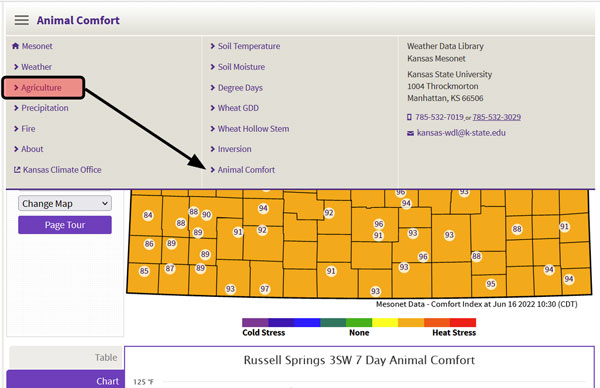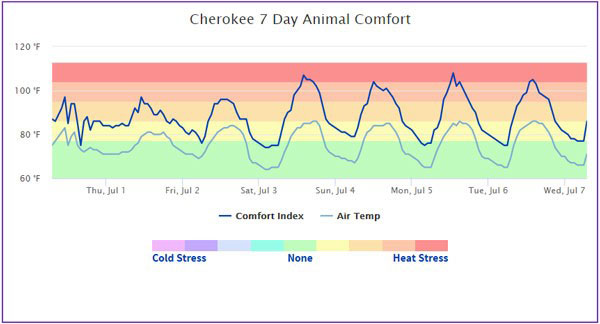Summer brings the heat, often amplified by humidity. With recent rains across the state, much of it in drought-stricken regions, there is no shortage of higher moisture in the air. When we factor in warmer-than-normal temperatures, especially at night, heat stress can rapidly develop in humans and animals alike. The Kansas Mesonet has an Animal Comfort Tool that helps track heat stress values at each location throughout the state.
When heat stress develops with hot, sunny, and humid conditions, increased proactive steps are required to avoid potential illness. This is compounded when heat stress values remain elevated for long periods of time. Of special importance is the animal’s ability to recover at night. Recent record high temperatures overnight prevent the body from recovering from the previous day’s heat and can compound the next day’s stress if not mitigated.
Actual animal response to temperature stress will depend on a number of factors not accounted for in the index. Those include, but are not limited to: age, hair coat (winter vs summer; wet vs dry), health, body condition, micro-environment, and acclimatization. However, despite some of these unknowns, producers can evaluate the environmental conditions to livestock by using the Kansas Mesonet Animal Comfort tool.
Users can access this tool from the main Mesonet page by selecting from the drop-down menu on the top left of every page, Agriculture, and then Comfort Index (Figure 1). Also, users can access the tool directly from this link: http://mesonet.k-state.edu/agriculture/animal/

Figure 1. Screenshot of the menu path to the Animal Comfort Index page on the Kansas Mesonet.
Understanding the Comfort Index
Building on the Comprehensive Comfort Index produced at University of Nebraska, this tool illustrates the impact of both extremes of hot and cold. The index is unique in that it includes, in addition to air temperature and relative humidity, effects of wind speed and solar radiation. Data from beef and dairy cattle was used in the development and validation of the index. The map indicates where current conditions fit on the scale.
Using the “Resources” tab on the webpage, users can learn more about the index, scale, and resulting potential impact (Figure 2). This also describes the colors used on the map and chart. In addition, users can examine the Nebraska publication if they would like to review the actual calculations.

Figure 2. Cattle comfort ranges. Graphic from Kansas Mesonet.
Tracking conditions
A particularly useful resource is the 7-day graph found under the “Chart” tab. This allows producers to monitor how conditions have fluctuated over the past week (Figure 3). Daily peaks can be expected each afternoon when temperatures are the warmest with peak solar radiation. Values then fall during the, usually cooler, overnight hours. Since stress impacts can be cumulative, having this feature allows producers to evaluate management requirements. This is especially a concern during warm overnights when values don’t drop below higher stress levels.

Figure 3. Animal Comfort index history at Cherokee County Mesonet station, near Columbus, KS. Graphic from Kansas Mesonet.
Accessing Historical Data
Unfortunately, since this information is calculated on an hourly basis, we do not keep a running archive of Animal Comfort that can be easily downloaded. From the “Download” tab, with the desired station selected, you can download the last week’s worth of data for that location. This is the same data that is displayed on the graph (Figure 3). If the data desired is outside the window of the last seven days, send an email request to Kansas-wdl@ksu.edu or one of the authors. We will pull the data and re-calculate the Animal Comfort for you.
Christopher “Chip” Redmond, Kansas Mesonet Manager
christopherredmond@ksu.edu
Matthew Sittel, Assistant State Climatologist
msittel@ksu.edu